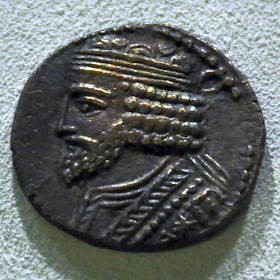Vardanes I
Vardanes I: Arsacid king of the Parthian Empire (r.29?-47?).

In 38 CE, the Parthian king Artabanus II died; his main achievement may have been that he had kept the kingdom together, although he first had to win a civil war against his brother Vonones I and had later won a civil war against another relative, Tiridates II. His son Vardanes I, who appears to have been co-ruler since 29 CE, succeeded him.note
Immediately, Vardanes' brother Gotarzes II, another son of Artabanus II, claimed the throne as well, but from coinage, we can deduce that at least from 40 to 45 Vardanes was in control of the state's mints. The exception may have been his capital Seleucia on the Tigris, which would be revolting for seven years.note
The conflict with Gotarzes II continued. The Roman historian Tacitus, who is confused about the date, tells that Gotarzes, with the support of the Hyrcanians and Dahae nomads, expelled his brother, who fled to Bactria, where he enlisted nomadic tribal warriors (perhaps the Yuezhi).note Before it came to battle, Vardanes convinced his brother to abandon his claims.note
Vardanes recaptured Seleucia - perhaps in 46? - and transferred his residence to Ctesiphon, on the opposite bank of the Tigris. The Roman historian Ammianus Marcellinus would later call Vardanes the founder of Ctesiphon,note which suggests that the king did something to improve the status of this city.
According to Tacitus, Vardanes wanted to intervene in Armenia, risking a conflict with the Romans.note If we are to believe third-century writer Philostratus, a wandering Greek philosopher named Apollonius advised him to give up his claim to several villages on the Euphrates and prevent war. The story is found in the Life of Apollonius and is not necessarily reliable.note
In c.47, Vardanes was assassinated. Gotarzes returned, died (51), and was succeeded by a man named Vonones II, who was immediately succeeded by his son Vologases I. In the end, this reunited the Parthian Empire again.
Note
The chronology of the Arsacid kings of the Parthian Empire is less well-understood than, for example, the sequence of Seleucid and Ptolemaic kings or the emperors of Rome. This information is based on the researches by G.R.F. Assar, as published in "Iran under the Arsakids, 247 BC – AD 224/227" in: Numismatic Art of Persia (2011).